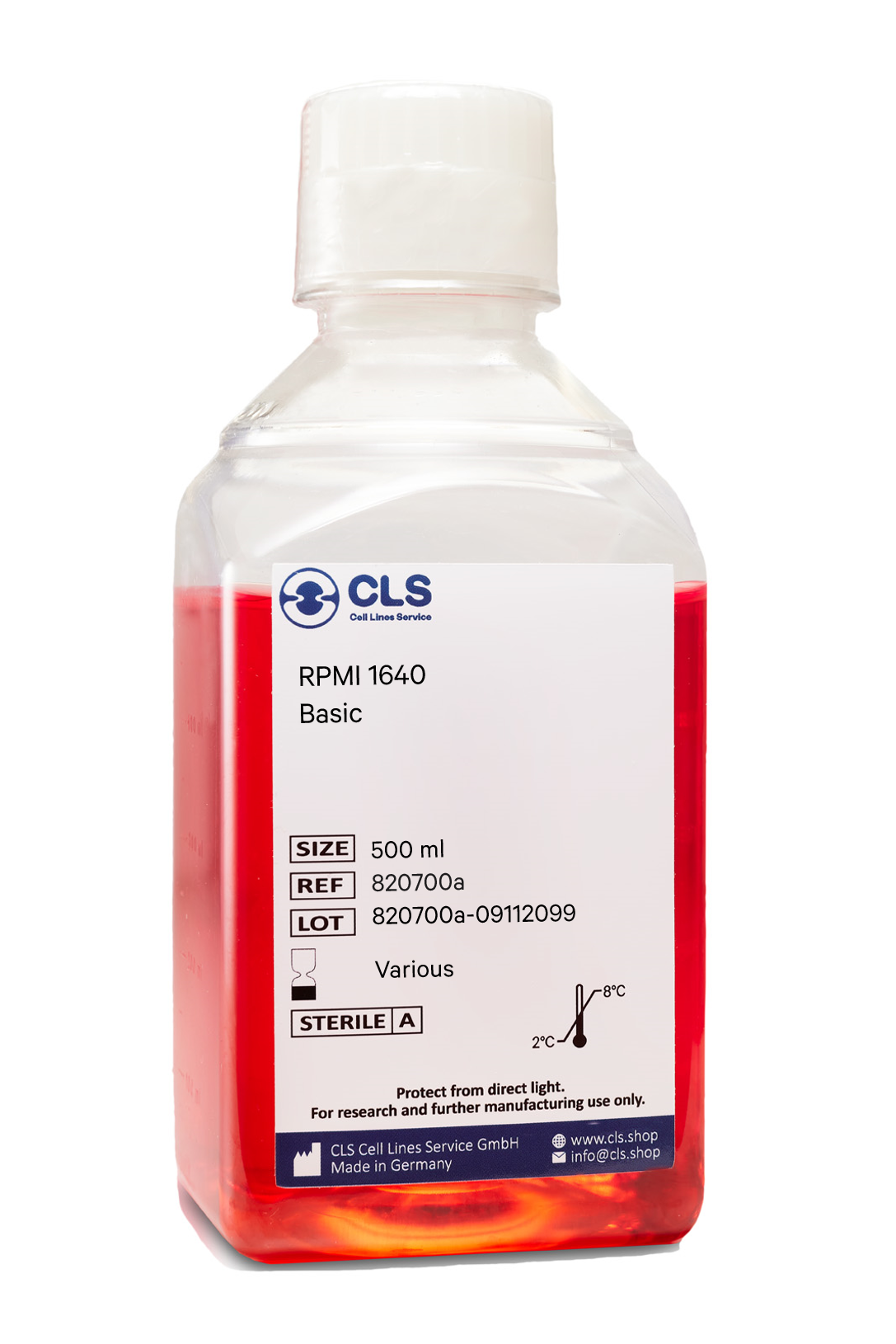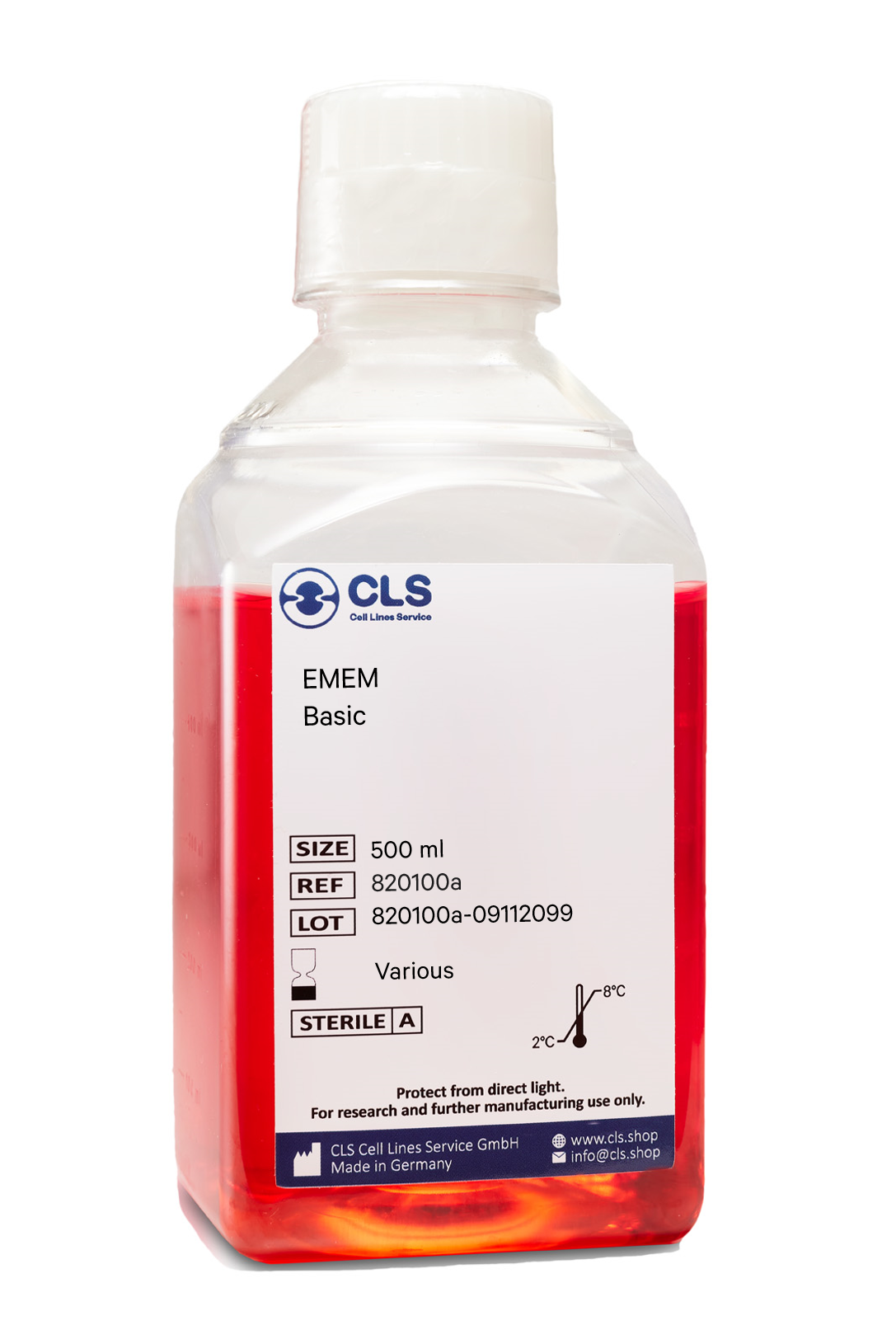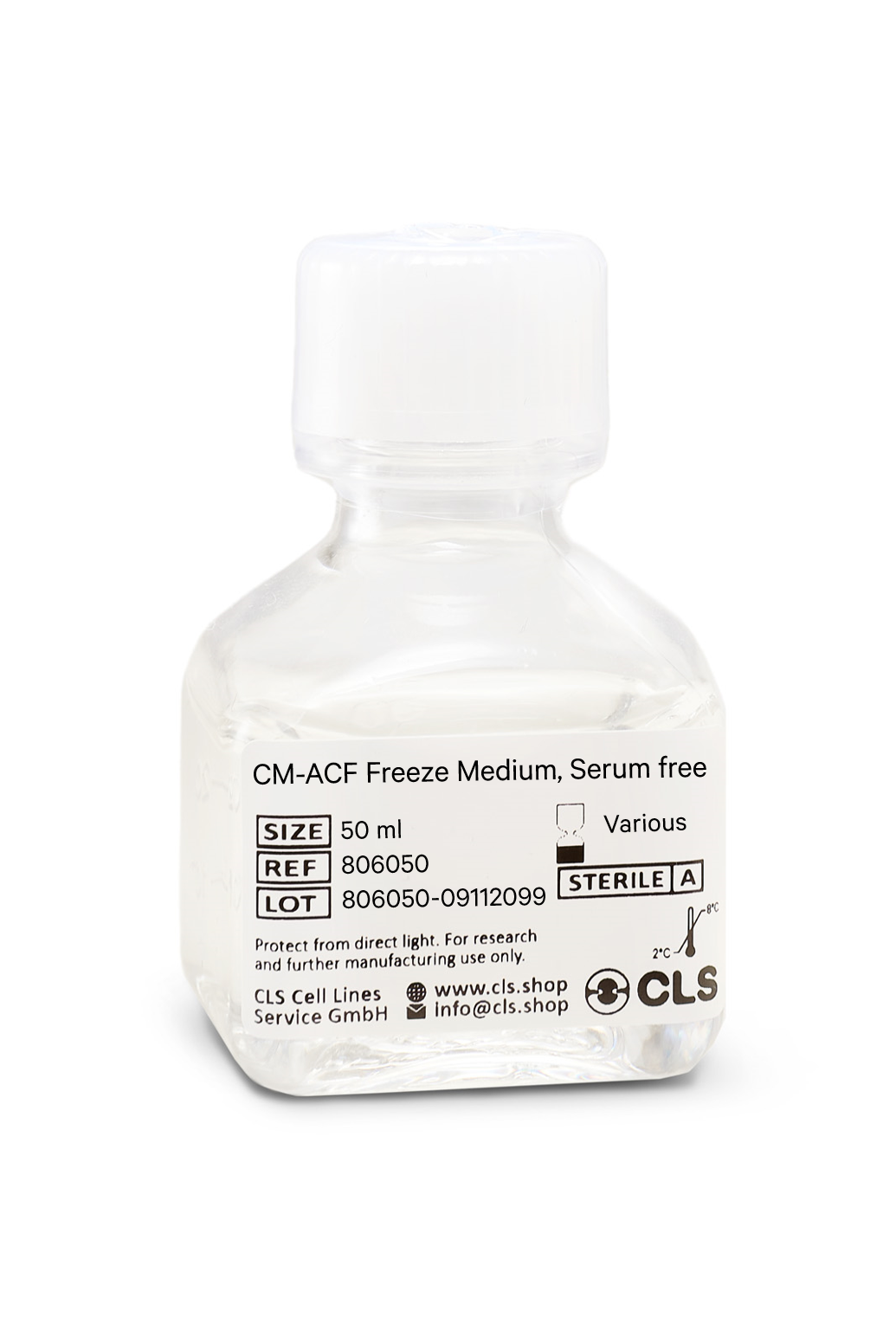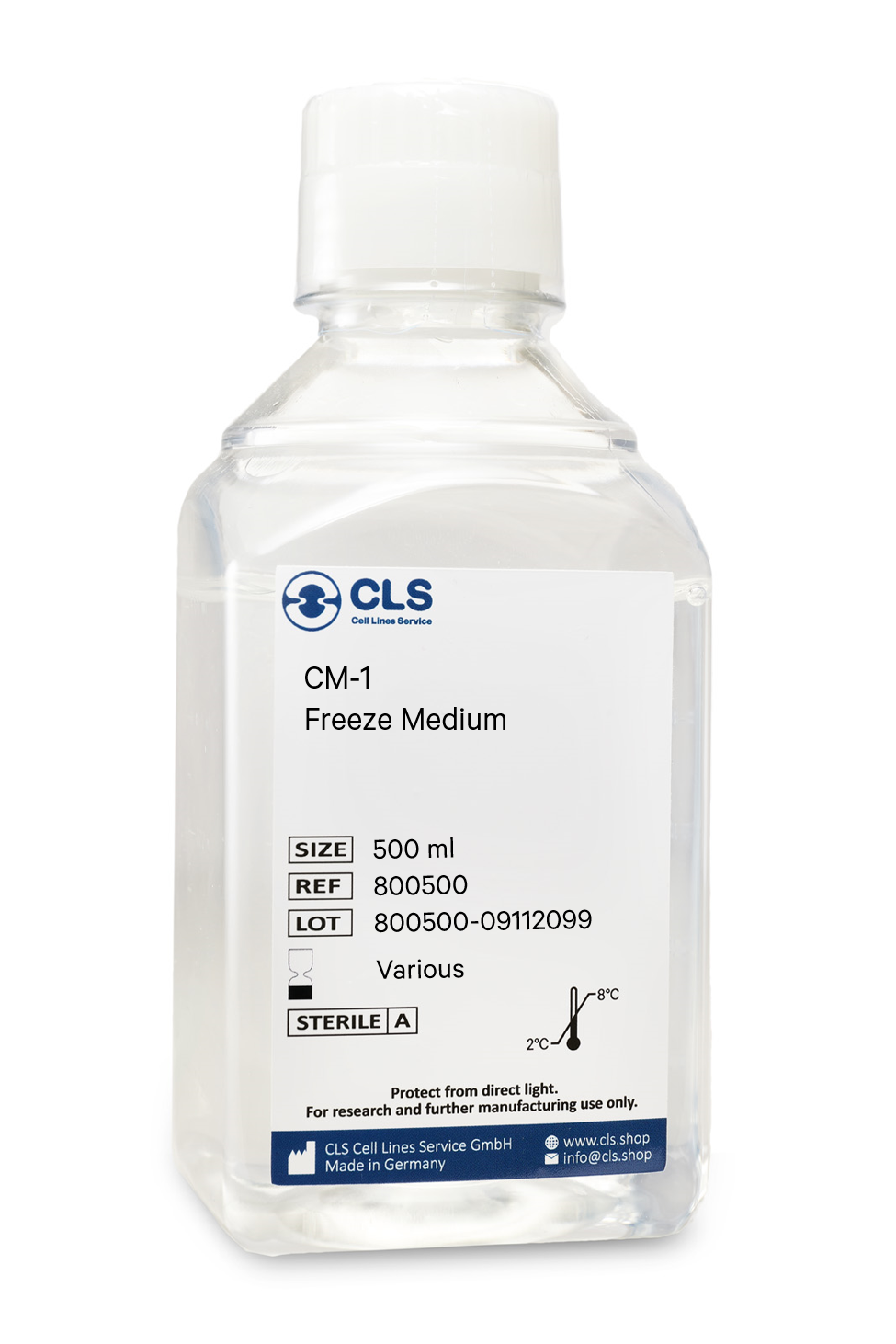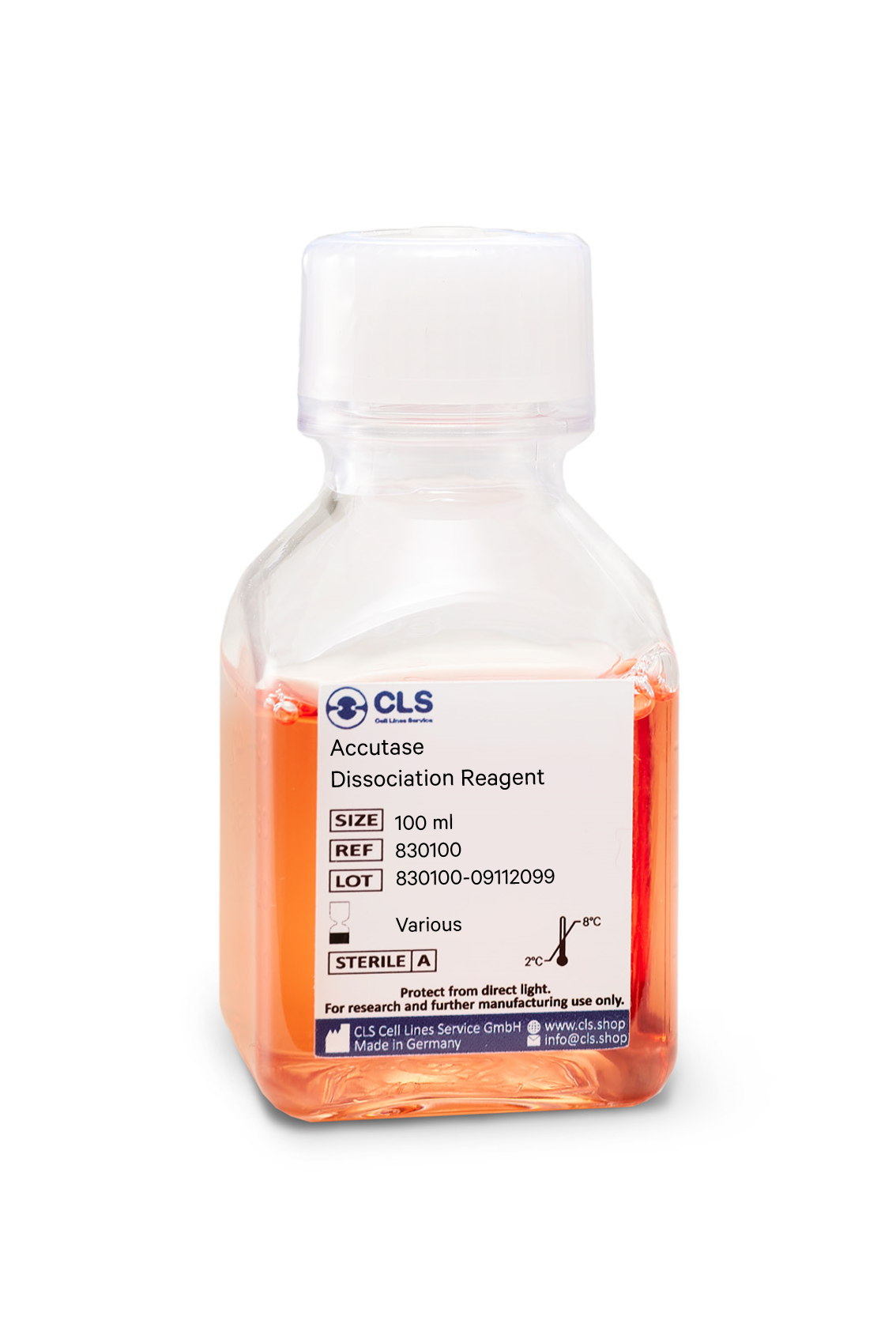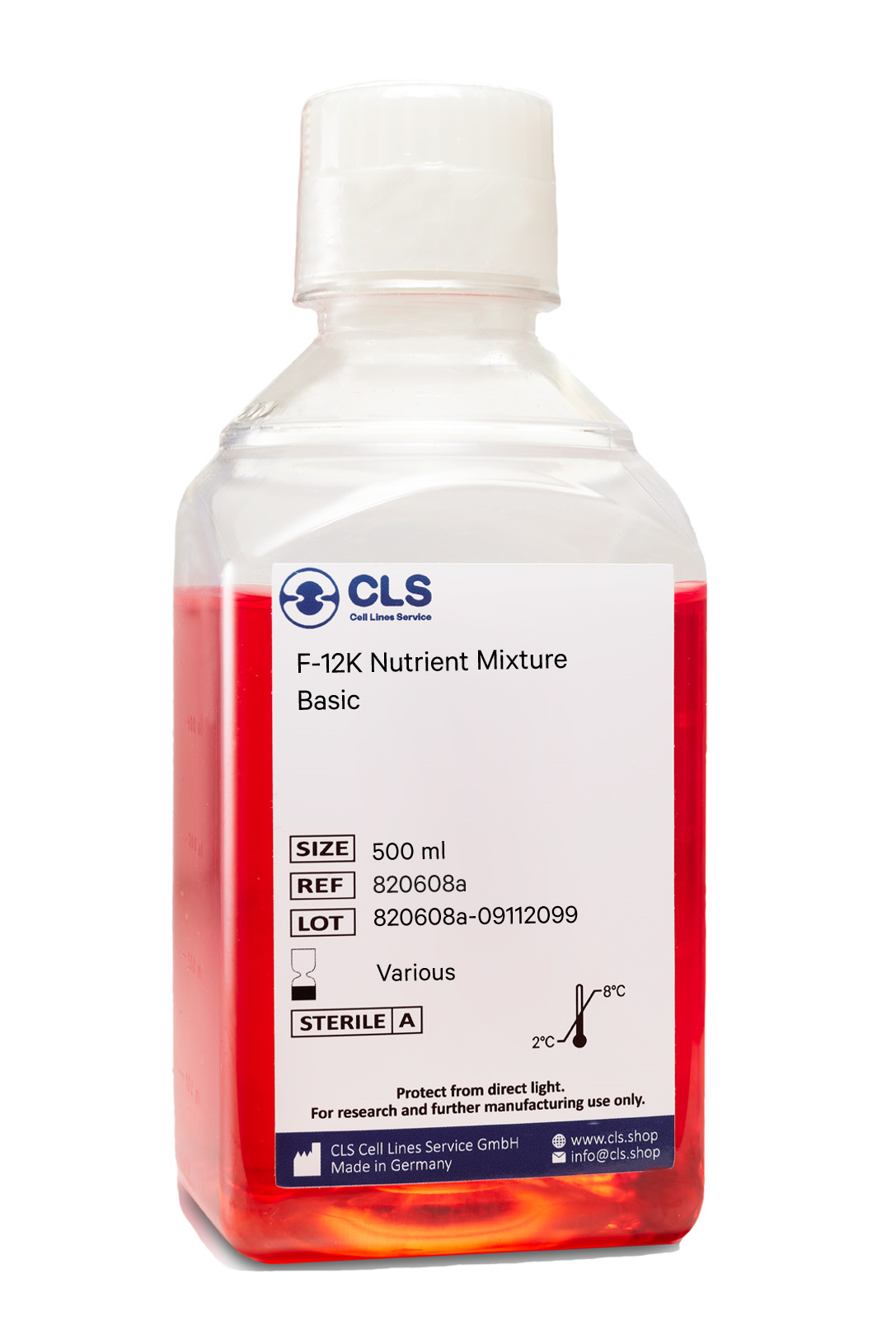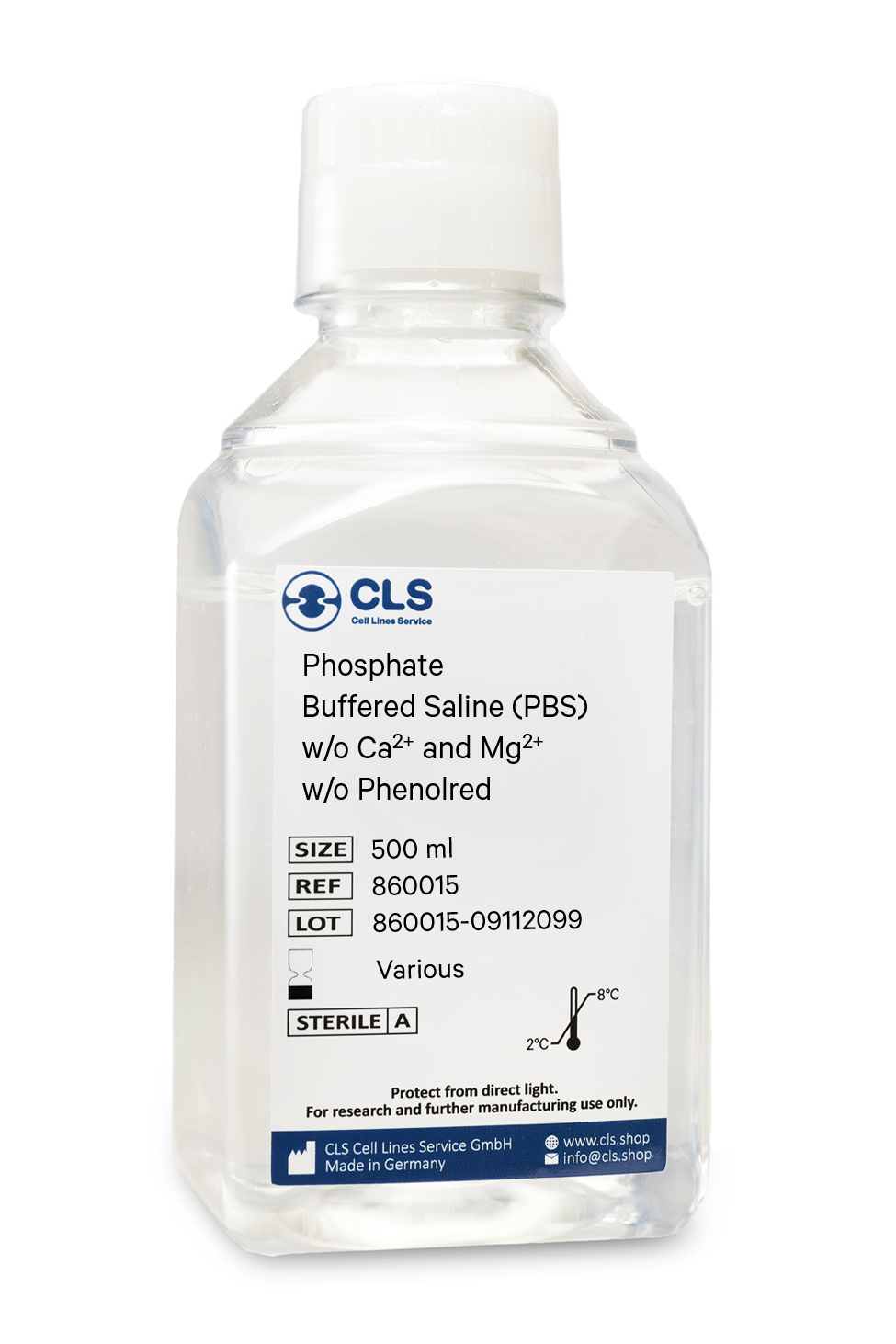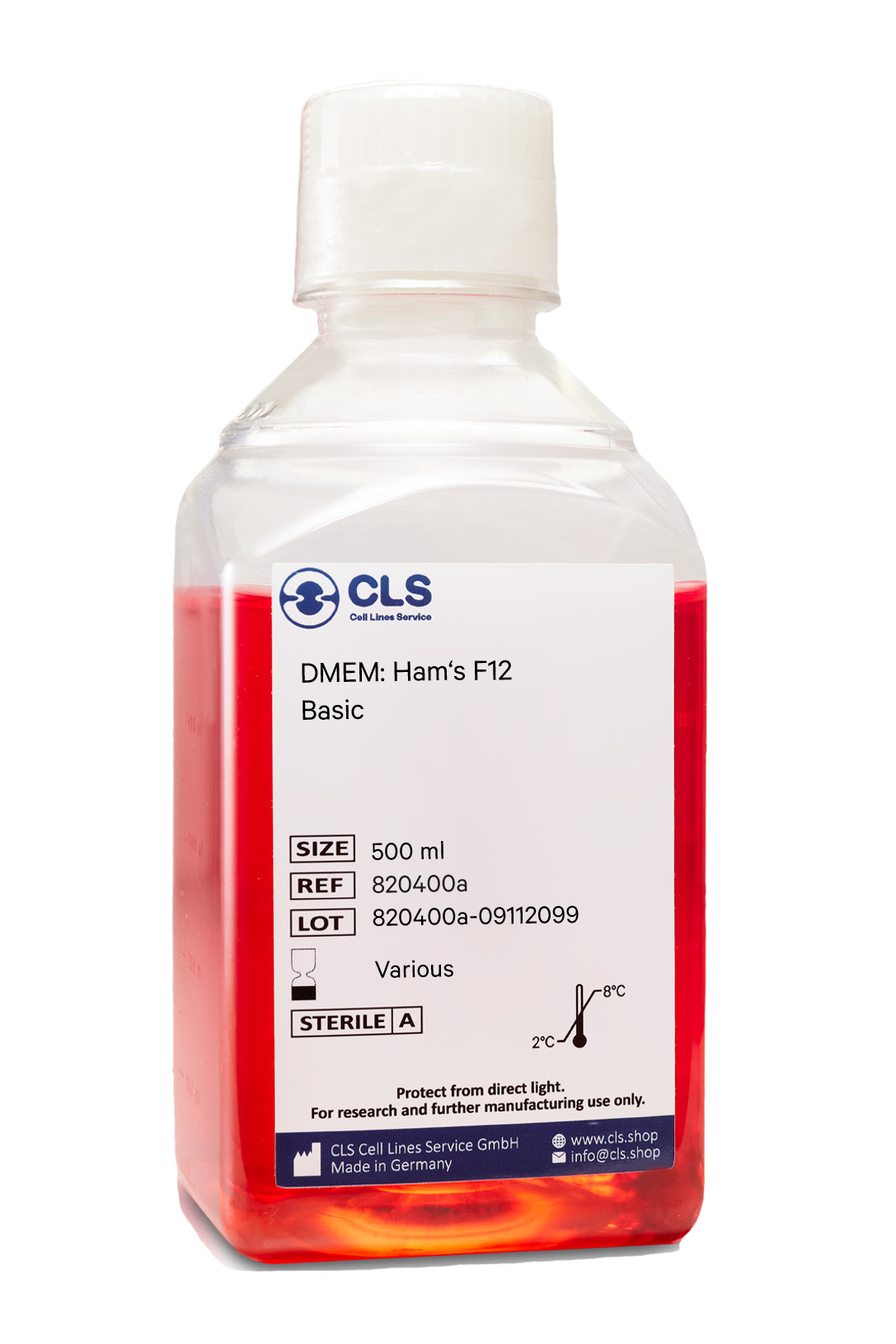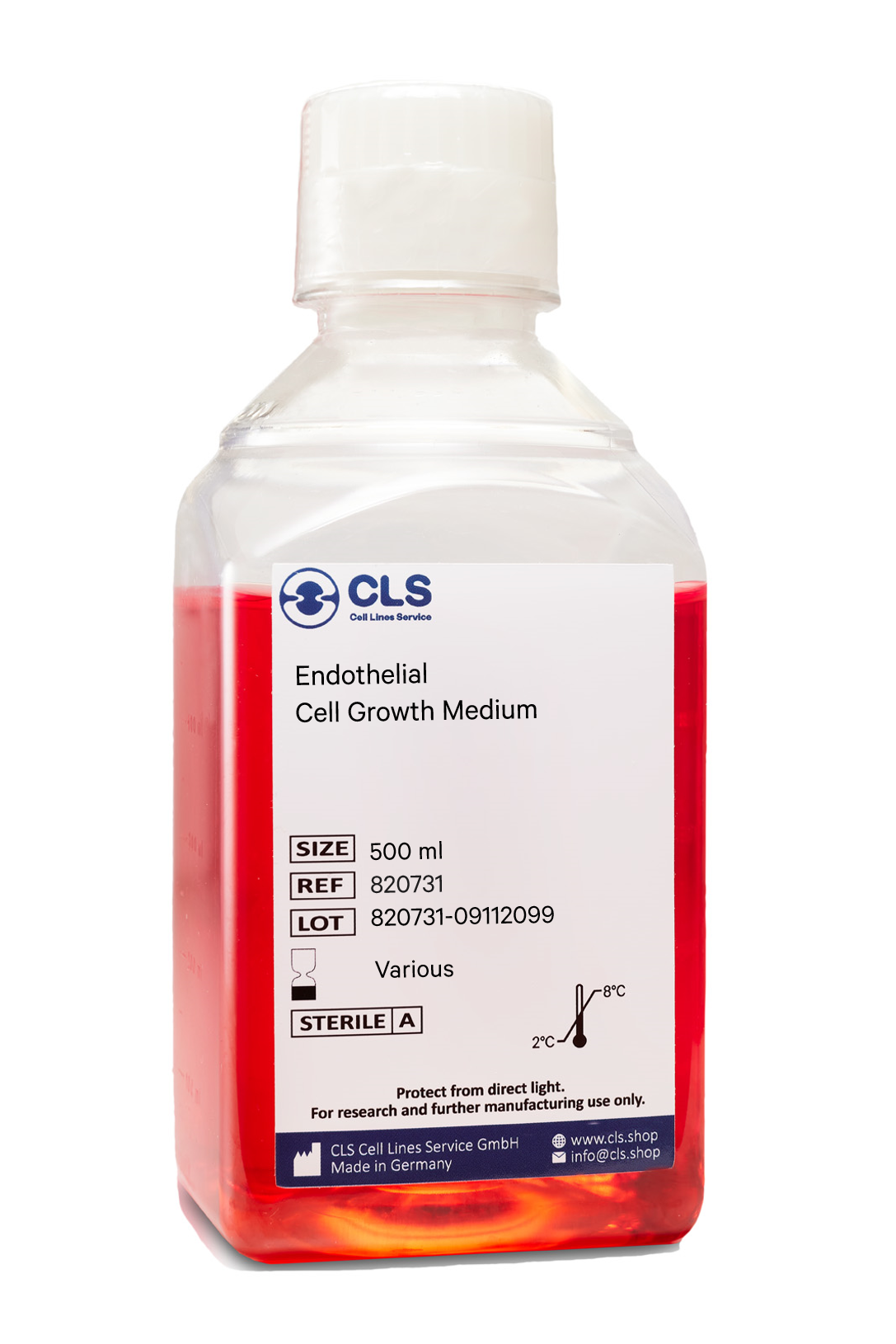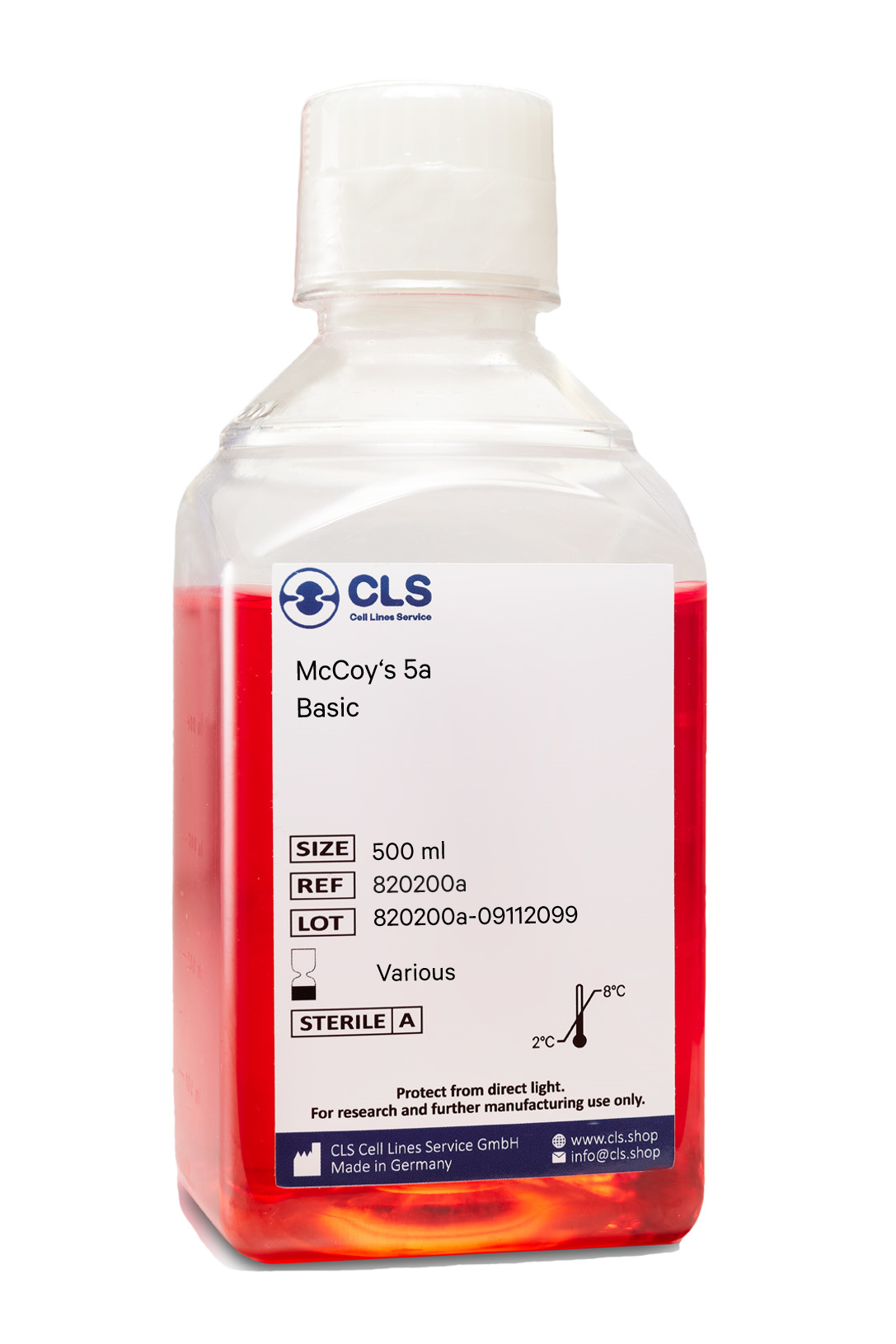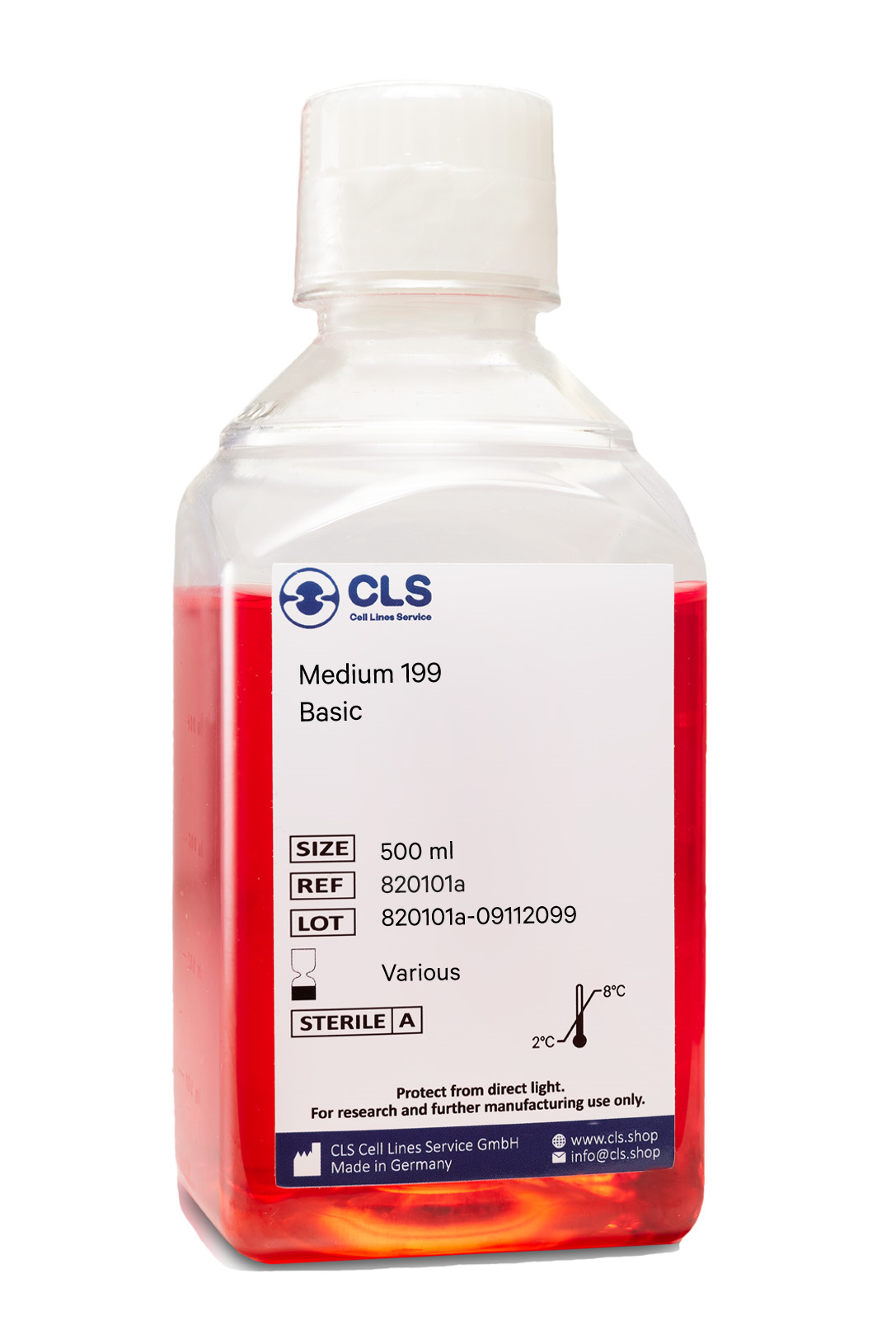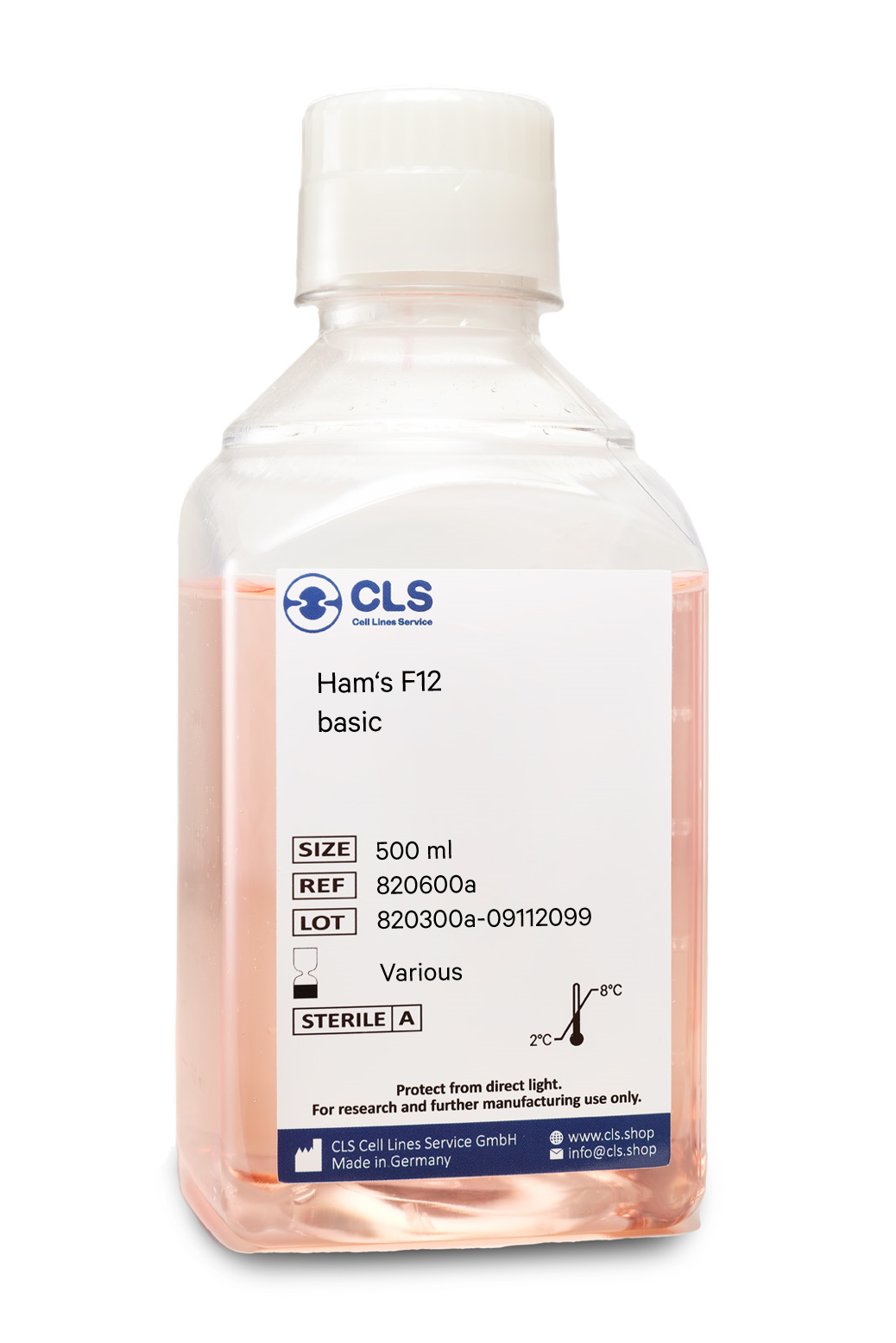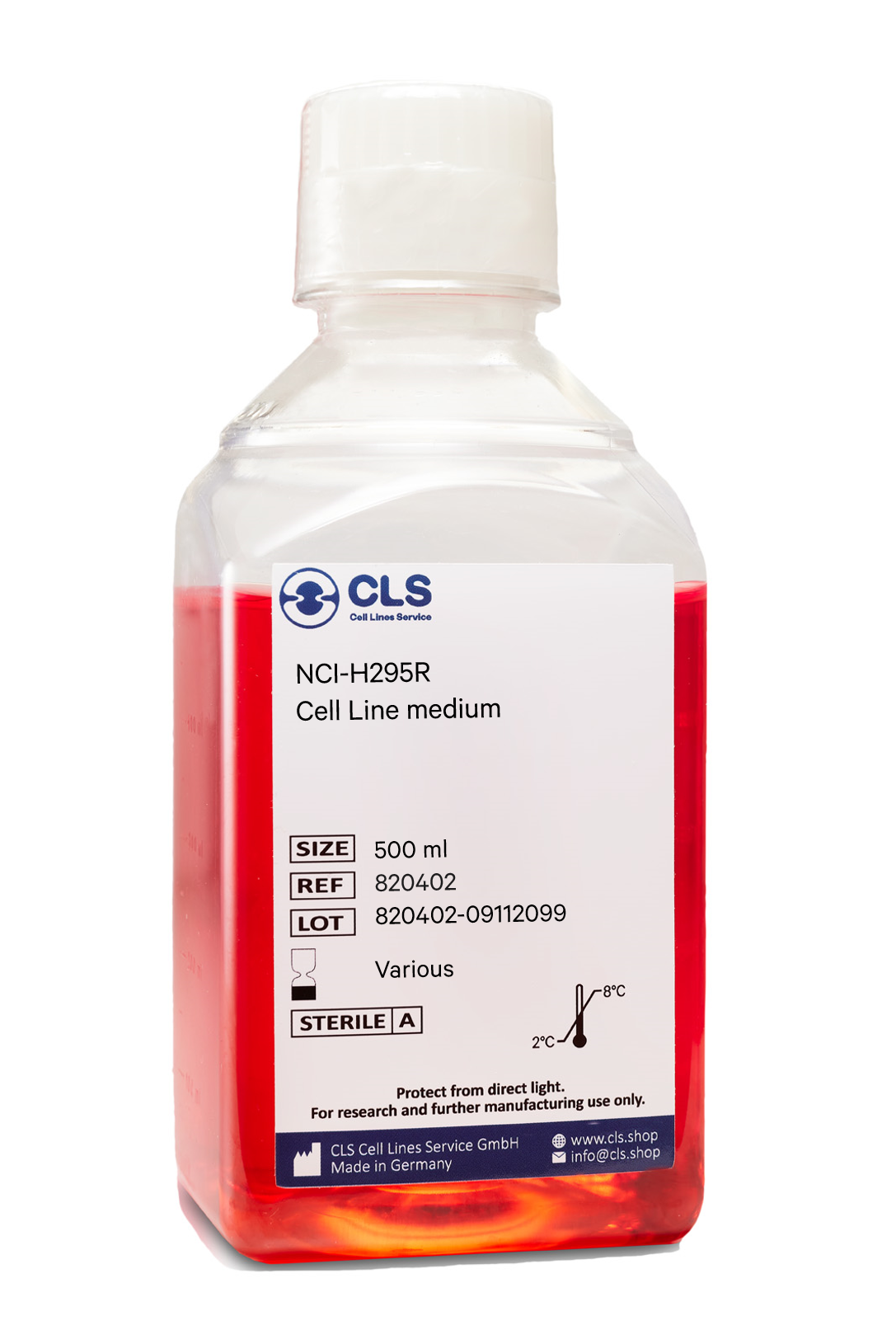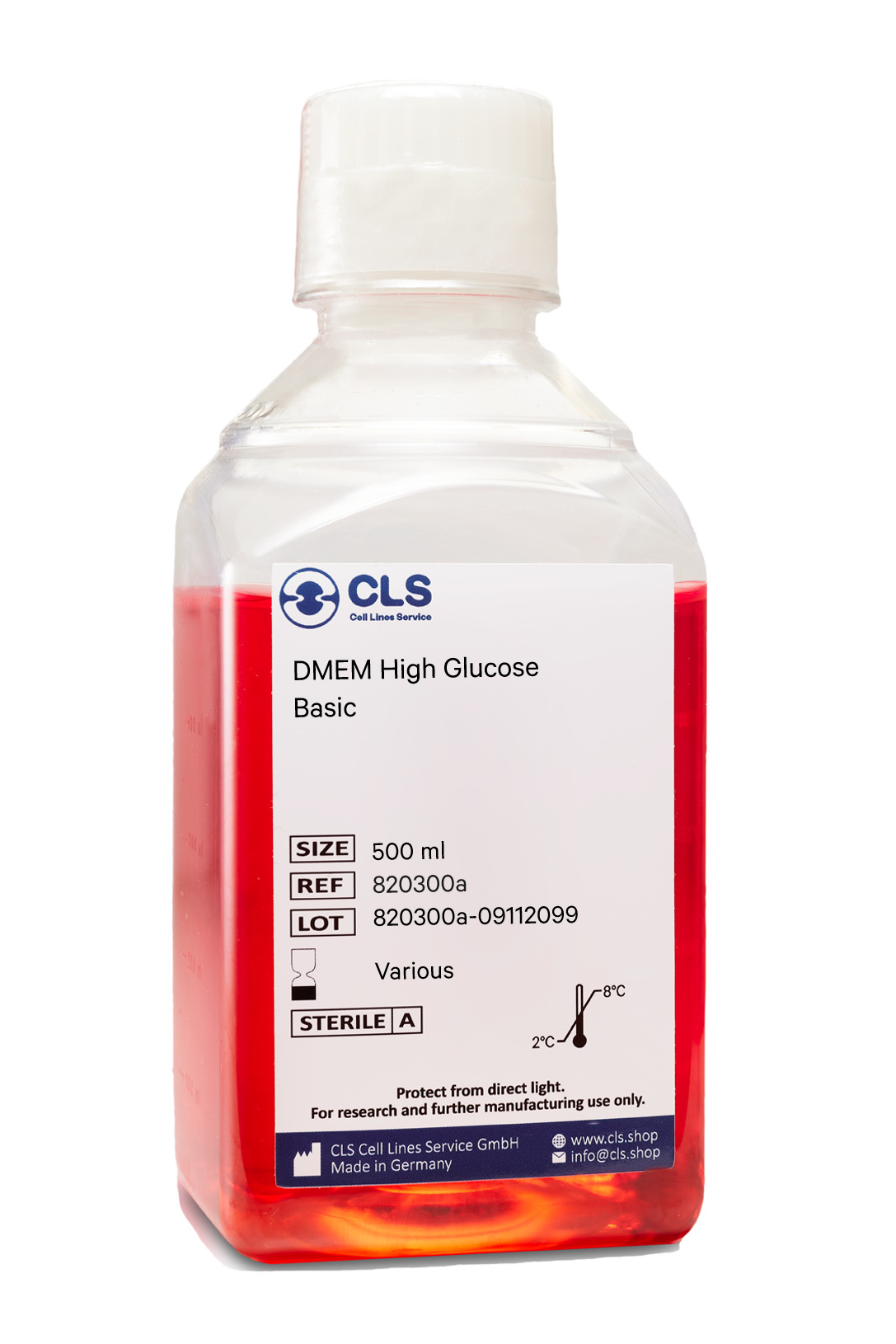Initially designed to support the growth of human leukemic cells in both suspension and monolayer cultures, RPMI 1640 Medium has evolved through modifications by researchers and commercial suppliers to become suitable for a diverse range of mammalian cells. It is exceptionally compatible with cell lines such as HeLa, Jurkat, MCF-7, PC12, PBMC, astrocytes, and carcinomas.
RPMI 1640 Medium stands apart from other cell culture media due to its unique composition. It contains a substantial amount of phosphate, amino acids, and vitamins. Notably, it encompasses biotin, vitamin B12, and PABA, absent in Eagle's Minimal Essential Medium or Dulbecco's Modified Eagle Medium. Moreover, RPMI 1640 Medium exhibits significantly elevated concentrations of vitamins inositol and choline. However, it does not contain proteins, lipids, or growth factors. Consequently, supplementation with 10% Fetal Bovine Serum (FBS) is commonly required to provide optimal conditions for cell growth.
The buffering system of RPMI 1640 Medium relies on sodium bicarbonate (2.0 g/L) and necessitates a 5-10% CO2 environment to maintain a physiologically appropriate pH. The inclusion of the reducing agent glutathione further distinguishes this medium from others.
This RPMI 1640 medium contains 4.5 grams per liter of glucose.
Quality control
pH = 7.2 +/
- 0.02 at 20-25°C.
Each lot has been tested for sterility and absence of mycoplasma and bacteria.
Maintenance
Keep refrigerated at +2°C to +8°C in the dark. Freezing and warming up to +37° C minimize the quality of the product.
Do not heat the medium to more than 37° C or use uncontrollable sources of heat (e.g., microwave appliances).
If only a part of the medium is to be used, remove this amount from the bottle and warm it up at room temperature.
Shelf life for any medium except for the basic medium is 8 weeks from the date of manufacture.
Composition
Components
mg/L
Inorganic Salts
Calcium nitrate x 4H2O
100,00
Magnesium sulfate anhydrous
48,83
Potassium chloride
400,00
Sodium chloride
5450,00
di-Sodium hydrogen phosphate
800,49
Other Components
D(+)-Glucose anhydrous
4500,00
Glutathione (red.)
1,00
HEPES
2383,00
Phenol red
5,00
Sodium pyruvate
110,00
Amino Acids
L-Arginine x HCl
241,86
L-Asparagine x H2O
56,82
L-Aspartic acid
20,00
L-Cystine x 2HCl
65,19
L-Glutamine
300,00
L-Glutamic acid
20,00
Glycine
10,00
L-Histidine x HCl x H2O
20,27
L-Hydroxyproline
20,00
L-Isoleucine
50,00
L-Leucine
50,00
L-Lysine x HCl
40,00
L-Methionine
15,00
L-Phenylalanine
15,00
L-Proline
20,00
L-Serine
30,00
L-Threonine
20,00
L-Tryptophan
5,00
L-Tyrosine x 2Na
28,83
L-Valine
20,00
Vitamins
p-Aminobenzoic acid
1,00
D-(+)-Biotin
0,20
D-Calcium pantothenate
0,25
Choline chloride
3,00
Folic acid
1,00
myo-Inositol
35,00
Nicotinamide
1,00
Pyridoxine x HCl
1,00
Riboflavin
0,20
Thiamine x HCl
1,00
Vitamin B12
0,01
NaHCO3
1500,00
This EMEM medium consists of 2 mM L-Glutamine, 1.5 g/L NaHCO3, EBSS, 1 mM Sodium pyruvate, and NEAA.
What's in EMEM?
EMEM is a modified version of Eagle's minimum essential medium, containing Earle's Balanced Salt Solution, non-essential amino acids, L-glutamine, sodium pyruvate, and sodium bicarbonate. It's important to note that this reduced level of sodium bicarbonate (NaHCO3, 1.5 g/L) is intended for use in 5% CO2 in the air. To maintain its effectiveness, storing the medium at two °C to 8°C in the dark when not in use is recommended.
What is EMEM used for?
Eagle's minimal essential medium (EMEM) is a cell culture medium that can maintain cells in tissue culture. The medium contains higher concentrations of amino acids, allowing for a more accurate approximation of the protein composition of cultured mammalian cells. EMEM may be used to cultivate various cells, including fibroblasts, human liver cancer cell line (HepG2) cells and human fetal brain progenitor-derived astrocyte cells (PDA). It is typically used in the presence of fetal bovine serum (FBS), calf, or horse sera.
How is EMEM different from other cell culture media?
While EMEM and Dulbecco's modified Eagle's medium (DMEM) share some similarities, they also differ. Both media lack protein and contain the amino acids, salts, glucose, and vitamins required to provide a cell with energy and maintain it in tissue culture. However, the DMEM formulation is modified to contain up to four times more vitamins and amino acids and two to four times more glucose than EMEM. It's worth noting that EMEM is also different from the original MEM formulation.
Quality control
pH = 7.2 +/
- 0.02 at 20-25°C.
Each lot has been tested for sterility and absence of mycoplasma and bacteria.
Maintenance
Keep refrigerated at +2°C to +8°C in the dark. Freezing and warming up to +37° C minimize the quality of the product.
Do not heat the medium to more than 37° C or use uncontrollable sources of heat (e.g., microwave appliances).
If only a part of the medium is to be used, remove this amount from the bottle and warm it up at room temperature.
Shelf life for any medium except for the basic medium is 8 weeks from the date of manufacture.
Composition
Components
mg/L
Inorganic Salts
Calcium chloride x 2H2O
264,92
Magnesium sulfate
97,67
Potassium chloride
400,00
Sodium chloride
6,800.00
Sodium dihydrogen phosphate x H2O
140,00
Other Components
D(+)-Glucose
1,000.00
Phenol red
10,00
Sodium pyruvate
110,00
NaHCO3
1,500.00
Amino Acids
L-Alanine
8,90
L-Arginine x HCl
126,00
L-Asparagine x H2O
13,20
L-Aspartic acid
13,30
L-Cystine
24,00
L-Glutamine
292,30
L-Glutamic acid
14,70
Glycine
7,50
L-Histidine x HCl x H2O
42,00
L-Isoleucine
52,00
L-Leucine
52,00
L-Lysine x HCl
72,50
L-Methionine
15,00
L-Phenylalanine
32,00
L-Proline
11,50
L-Serine
10,50
L-Threonine
48,00
L-Tryptophan
10,00
L-Tyrosine
36,00
L-Valine
46,00
Vitamins
D-Calcium pantothenate
1,00
Choline chloride
1,00
Folic acid
1,00
myo-Inositol
2,00
Nicotinamide
1,00
Pyridoxal x HCl
1,00
Riboflavin
0,10
Thiamine x HCl
1,00
In biological research, the cryopreservation of mammalian cells is an invaluable tool. Successful preservation of cells is a top priority given that losing a cell line to contamination or improper storage conditions leads to lost time and money, ultimately delaying research results. Once the cells have been transferred from a cell growth medium to a freezing medium, the cells are typically frozen at a regulated rate and stored in liquid nitrogen vapor or at below -130°C in a mechanical deep freezer. The freeze medium CM-ACF enables cryopreservation of cells at below -130°C (or in liquid nitrogen), essentially eliminating the need for an additional, costly ultralow freezer and eliminating time-consuming and demanding controlled rate freezing processes. Simply collect the cells, aspirate the growth medium, resuspend in CM-ACF, transfer to a cryovial, and store the vial at below -130 °C.
Long shelf-life
CM-ACF is a serum-free, ready-to-use cryopreservation medium that can be stored in the refrigerator for up to one year.
Trusted by hundreds of researchers
Our advanced, serum-free cell freezing medium CM-ACF is a market-leading product in Germany and Europe and is distinguished by numerous publications involving hundreds of different cell lines worldwide. We tested it with more than 1000 cell lines from our proprietary cell bank.
Optimized serum-free ingredients
CM-ACF does not contain serum products. Serum-containing cryopreservation mediums have the disadvantage of fluctuating recovery rates and unclear composition. Since the composition and concentration of proteins and other biological components vary from batch to batch in serum, the reproducibility of experiments with cells that were frozen in a serum-containing medium may be compromised. As each component of CM-ACF is carefully defined, you can rest assured that cells always recover identically.
Contains DMSO, glucose, salts
Buffering capacity pH = 7.2 to 7.6
Universal
- even for stem cell preservation
All common cell lines can be frozen and thawed to yield many viable cells. Compared to standard media, the rate of recovery of even the most delicate cells is significantly higher. Using CM-ACF, we store over 1000 different cell lines with outstanding success.
Applications & Validation
The cells preserved in our CM-ACF freeze medium can be used for cell counting, viability and cryopreservation, cell culture, mammalian cell culture, gene expression analysis and genotyping, in vitro transcription, and polymerase chain reactions. Each batch's efficacy is evaluated using CHO-K1 cells. Each batch is tested for pH, osmolality, sterility, and endotoxins to ensure high quality.
In biological research, the cryopreservation of mammalian cells is an invaluable tool. Successful preservation of cells is a top priority given that losing a cell line to contamination or improper storage conditions leads to lost time and money, ultimately delaying research results. Once the cells have been transferred from a cell growth medium to a freezing medium, the cells are typically frozen at a regulated rate and stored in liquid nitrogen vapor or at below -130°C in a mechanical deep freezer. The freeze medium CM-1 enables cryopreservation of cells at below -130°C (or in liquid nitrogen), essentially eliminating the need for an additional, costly ultralow freezer and eliminating time-consuming and demanding controlled rate freezing processes. Simply collect the cells, aspirate the growth medium, resuspend in CM-1, transfer to a cryovial, and store the vial at below -130 °C.
Long shelf-life
CM-1 is a serum-containing, ready-to-use cryopreservation medium that can be stored in the refrigerator for up to one year.
Trusted by hundreds of researchers
Our advanced cell freezing medium CM-1 is a market-leading product in Germany and Europe and is distinguished by numerous publications involving hundreds of different cell lines worldwide. We tested it with more than 1000 cell lines from our proprietary cell bank.
Optimized ingredients
CM-1 does contain serum products. Serum-containing cryopreservation mediums optimally protect the cells whilst being frozen and have the advantage of high recovery rates. As CM-1 has been tested with a multitude of cell lines, you can rest assured that your cells always recover well.
Contains FBS, DMSO, glucose, salts
Buffering capacity pH = 7.2 to 7.6
Applications & Validation
The cells preserved in our CM-1 freeze medium can be used for cell counting, viability and cryopreservation, cell culture, mammalian cell culture, gene expression analysis and genotyping, in vitro transcription, and polymerase chain reactions. Each batch's efficacy is evaluated using CHO-K1 cells. Each batch is tested for pH, osmolality, sterility, and endotoxins to ensure high quality.
- A Gentle Alternative to Trypsin
Accutase is a cell detachment solution that is revolutionizing the cell culture industry. It is a mix of proteolytic and collagenolytic enzymes that mimics the action of trypsin and collagenase. Unlike trypsin, Accutase does not contain any mammalian or bacterial components and is much gentler on cells, making it an ideal solution for the routine detachment of cells from standard tissue culture plasticware and adhesion coated plasticware. In this blog post, we will explore the benefits and uses of Accutase and how it is changing the game in cell culture.
Advantages of Accutase
Accutase has several advantages over traditional trypsin solutions. Firstly, it can be used whenever gentle and efficient detachment of any adherent cell line is needed, making it a direct replacement for trypsin. Secondly, Accutase works extremely well on embryonic and neuronal stem cells, and it has been shown to maintain the viability of these cells after passaging. Thirdly, Accutase preserves most epitopes for subsequent flow cytometry analysis, making it ideal for cell surface marker analysis.
Additionally, Accutase does not need to be neutralized when passaging adherent cells. The addition of more media after the cells are split dilutes Accutase so it is no longer able to detach cells. This eliminates the need for an inactivation step and saves time for cell culture technicians. Finally, Accutase does not need to be aliquoted, and a bottle is stable in the refrigerator for 2 months.
Applications of Accutase
Accutase is a direct replacement for trypsin solution and can be used for the passaging of cell lines. Additionally, Accutase performs well when detaching cells for the analysis of many cell surface markers using flow cytometry and for cell sorting. Other downstream applications of Accutase treatment include analysis of cell surface markers, virus growth assay, cell proliferation, tumor cell migration assays, routine cell passage, production scale-up (bioreactor), and flow cytometry.
Composition of Accutase
Accutase contains no mammalian or bacterial components and is a natural enzyme mixture with proteolytic and collagenolytic enzyme activity. It is formulated at a much lower concentration than trypsin and collagenase, making it less toxic and gentler, but just as effective.
Efficiency of Accutase
Accutase has been shown to be efficient in detaching primary and stem cells and maintaining high cell viability compared to animal origin enzymes such as trypsin. 100% of cells are recovered after 10 minutes, and there is no harm in leaving cells in Accutase for up to 45 minutes, thanks to autodigestion of Accutase.
In summary
In conclusion, Accutase is a powerful solution that is changing the game in cell culture. With its gentle nature, efficiency, and versatility, Accutase is the ideal alternative to trypsin. If you are looking for a reliable and efficient solution for cell detachment, Accutase is the solution for you.
Ham's F-12K (Kaighn's) Medium is carefully formulated to optimize cell culture conditions. It features an enriched composition, providing elevated levels of essential components such as amino acids and sodium pyruvate, as well as additional elements including putrescine, thymidine, hypoxanthine, and zinc. These additions enable researchers to supplement the medium with minimal serum or defined components for specific cell types, facilitating precise experimental conditions.
Notably, Ham's F-12K (Kaighn's) Medium does not contain proteins or growth factors. Consequently, supplementation with growth factors and Fetal Bovine Serum (FBS) is often necessary, allowing researchers to tailor the medium to the requirements of their specific cell lines. For optimal performance, the concentration of FBS must be carefully optimized for each cell line, ensuring optimal growth and functionality.
To maintain physiological pH, Ham's F-12K (Kaighn's) Medium employs a sodium bicarbonate buffer system (2.5 g/L), necessitating a controlled 5-10% CO2 environment during cultivation. This ensures the medium's pH remains within the ideal range for cell growth and viability.
Quality control
pH = 7.2 +/
- 0.02 at 20-25°C.
Each lot has been tested for sterility and absence of mycoplasma and bacteria.
Maintenance
Keep refrigerated at +2°C to +8°C in the dark. Freezing as well as warming up to +37°C minimize the quality of the product.
Do not heat the medium to more than 37°C or use uncontrollable sources of heat (e.g., microwave appliances).
If only a part of the medium is to be used, remove this amount from the bottle and warm it up at room temperature.
Shelf life for any medium but the basic medium is 8 weeks from the date of manufacture.
Composition
Components
mg/L
Inorganic Salts
Calcium chloride x 2H2O
135,24
Copper(II) sulfate x 5H2O
0,00
Iron (II) sulfate x 7H2O
0,83
Magnesium chloride x 6H2O
105,72
Magnesium sulfate x 7H2O
394,49
Potassium chloride
283,29
Potassium dihydrogen phosphate
58,52
Sodium chloride
7597,20
di-Sodium hydrogen phosphateanhydrous
115,02
Zinc sulfate x 7H2O
0,14
Other Components
D(+)-Glucose anhydrous
1260,00
Hypoxanthine
4,08
DL-α-Lipoic acid
0,21
Phenol red
3,00
Putrescine x 2HCl
0,32
Sodium pyruvate
220,00
NaHCO3
2500,00
Thymidine
0,73
Amino Acids
L-Alanine
17,82
L-Arginine x HCl
421,40
L-Asparagine x H2O
30,02
L-Aspartic acid
26,62
L-Cysteine x HCl x H2O
70,24
L-Glutamine
292,20
L-Glutamic acid
29,42
Glycine
15,01
L-Histidine x HCl x H2O
41,92
L-Isoleucine
7,87
L-Leucine
26,24
L-Lysine x HCl
73,04
L-Methionine
8,95
L-Phenylalanine
9,91
L-Proline
69,06
L-Serine
21,02
L-Threonine
23,82
L-Tryptophan
4,08
L-Tyrosine
10,87
L-Valine
23,42
Vitamins
D(+)-Biotin
0,07
D-Calcium pantothenate
0,48
Choline chloride
13,96
Folic acid
1,32
myo-Inositol
18,02
Nicotinamide
0,04
Pyridoxine x HCl
0,06
Riboflavin
0,04
Thiamine x HCl
0,34
Vitamin B12
1,36
Phosphate-buffered saline (PBS) is a versatile buffer solution used in many biological and chemical applications, as well as tissue processing. Our PBS solution is formulated with high-quality ingredients to ensure a constant pH during experiments. The osmolarity and ion concentrations of our PBS solution are matched to those of the human body, making it isotonic and non-toxic to most cells.
Composition of our PBS Solution
Our PBS solution is a pH-adjusted blend of ultrapure-grade phosphate buffers and saline solutions. At a 1X working concentration, it contains 137 mM NaCl, 2.7 mM KCl, 8 mM Na2HPO4, and 2 mM KH2PO4. We have chosen this composition based on CSHL protocols and Molecular cloning by Sambrook, which are well-established standards in the research community.
Applications of our PBS Solution
Our PBS solution is ideal for a wide range of applications in biological research. Its isotonic and non-toxic properties make it perfect for substance dilution and cell container rinsing. Our PBS solution with EDTA can also be used to disengage attached and clumped cells. However, it is important to note that divalent metals such as zinc cannot be added to PBS as this may result in precipitation. In such cases, Good's buffers are recommended. Moreover, our PBS solution has been shown to be an acceptable alternative to viral transport medium for the transport and storage of RNA viruses, such as SARS-CoV-2.
Storage of our PBS Solution
Our PBS solution can be stored at room temperature, making it easy to use and access.
To sum up
In summary, our PBS solution is an essential component in many biological and chemical experiments. Its isotonic and non-toxic properties make it suitable for numerous applications, from cell culture to viral transport medium. By choosing our high-quality PBS solution, researchers can optimize their experiments and ensure accurate and reliable results.
Composition
Components
mg/L
Inorganic Salts
Potassium chloride
200,00
Potassium dihydrogen phosphate
200,00
Sodium chloride
8,000.00
di-Sodium hydrogen phosphate anhydrous
1,150.00
Initially designed to support the growth of human leukemic cells in both suspension and monolayer cultures, RPMI 1640 Medium has evolved through modifications by researchers and commercial suppliers to become suitable for a diverse range of mammalian cells. It is exceptionally compatible with cell lines such as HeLa, Jurkat, MCF-7, PC12, PBMC, astrocytes, and carcinomas.
RPMI 1640 Medium stands apart from other cell culture media due to its unique composition. It contains a substantial amount of phosphate, amino acids, and vitamins. Notably, it encompasses biotin, vitamin B12, and PABA, absent in Eagle's Minimal Essential Medium or Dulbecco's Modified Eagle Medium. Moreover, RPMI 1640 Medium exhibits significantly elevated concentrations of vitamins inositol and choline. However, it does not contain proteins, lipids, or growth factors. Consequently, supplementation with 10% Fetal Bovine Serum (FBS) is commonly required to provide optimal conditions for cell growth.
The buffering system of RPMI 1640 Medium relies on sodium bicarbonate (2.0 g/L) and necessitates a 5-10% CO2 environment to maintain a physiologically appropriate pH. The inclusion of the reducing agent glutathione further distinguishes this medium from others.
The unique composition of this RPMI formulation comprises 2.1 mM of stable Glutamine, 2.0 grams per liter of NaHCO3, and phenol red.
Quality control
pH = 7.2 +/
- 0.02 at 20-25°C.
Each lot has been tested for sterility and absence of mycoplasma and bacteria.
Maintenance
Keep refrigerated at +2°C to +8°C in the dark. Freezing and warming up to +37° C minimize the quality of the product.
Do not heat the medium to more than 37° C or use uncontrollable sources of heat (e.g., microwave appliances).
If only a part of the medium is to be used, remove this amount from the bottle and warm it up at room temperature.
Shelf life for any medium except for the basic medium is 8 weeks from the date of manufacture.
Composition
Components
mg/L
Inorganic Salts
Calcium nitrate x 4H2O
100,00
Magnesium sulfate anhydrous
48,83
Potassium chloride
400,00
Sodium chloride
5,950.00
di-Sodium hydrogen phosphate
800,49
Other Components
D(+)-Glucose anhydrous
2,000.00
Glutathione (red.)
1,00
Phenol red
5,00
NaHCO3
2,000.00
Amino Acids
L-Arginine x HCl
241,86
L-Asparagine x H2O
56,82
L-Aspartic acid
20,00
L-Cystine x 2HCl
65,19
L-Alanyl-L-Glutamine
447,00
L-Glutamic acid
20,00
Glycine
10,00
L-Histidine x HCl x H2O
20,27
L-Hydroxyproline
20,00
L-Isoleucine
50,00
L-Leucine
50,00
L-Lysine x HCl
40,00
L-Methionine
15,00
L-Phenylalanine
15,00
L-Proline
20,00
L-Serine
30,00
L-Threonine
20,00
L-Tryptophan
5,00
L-Tyrosine x 2Na
28,83
L-Valine
20,00
Vitamins
p-Aminobenzoic acid
1,00
D-(+)-Biotin
0,20
D-Calcium pantothenate
0,25
Choline chloride
3,00
Folic acid
1,00
myo-Inositol
35,00
Nicotinamide
1,00
Pyridoxine x HCl
1,00
Riboflavin
0,20
Thiamine x HCl
1,00
Vitamin B12
0.005
This unique formulation combines Dulbecco's Modified Eagle Medium (DMEM) and Ham's F-12 (Ham's Nutrient Mixture F-12) in a precise 1:1 ratio. The addition of L-glutamine further enhances its composition.
DMEM, derived from Eagle's Minimal Essential Medium (EMEM), offers an increased concentration of amino acids and vitamins compared to its predecessor. In contrast, Ham's F-12 is based on Ham's F-10 medium, providing a complementary set of essential components.
To support optimal cell growth, it is common practice to supplement DMEM:Ham's F12 with FBS at a typical concentration of 5-10%. This addition is necessary as the medium lacks growth hormones, lipids, and proteins crucial for cellular development.
DMEM:Ham's F12 incorporates a pH buffer system and is often supplemented with phenol red, a pH indicator. Cultured cells in DMEM:Ham's F12, or any medium utilizing the bicarbonate buffer system, require a controlled CO2 environment of 5-10% to maintain appropriate pH levels. Phenol red enables monitoring of pH changes from 6.2 (yellow) to 8.2 (red).
Quality Control
pH = 7.2 +/
- 0.02 at 20-25°C.
Each lot has been tested for sterility and absence of mycoplasma and bacteria.
Maintenance
Keep refrigerated at +2°C to +8°C in the dark. Freezing as well as warming up to +37°C minimize the quality of the product.
Do not heat the medium to more than 37°C or use uncontrollable sources of heat (e.g., microwave appliances).
If only a part of the medium is to be used, remove this amount from the bottle and warm it up at room temperature.
Shelf life for any medium except for the basic medium is 8 weeks from the date of manufacture.
Composition
Components
mg/L
Inorganic Salts
Calcium chloride x 2H2O
154,45
Iron(III)-nitrate x 9H2O
0,05
Iron(II)-sulfate x 7H2O
0,42
Potassium chloride
311,83
Copper(II)-sulfate x 5H2O
0.001
Magnesium chloride anhydrous
28,57
Magnesium sulfate
48,85
Sodium chloride
6,999.50
Sodium dihydrogen phosphate anhydrous
54,35
di-Sodium hydrogen phosphate
70,98
Zinc sulfate x 7H2O
0,43
Other Components
D(+)-Glucose anhydrous
3,151.00
HEPES
3,574.50
Hypoxanthine
2,04
Linoleic acid
0,04
DL-68-Lipoic acid
0.103
Sodium pyruvate
110,00
Phenol red
8,10
Putrescin x 2HCl
0.081
Thymidine
0,36
Amino Acids
L-Alanine
4,45
L-Arginine x HCl
147,35
L-Asparagine x H2O
7,50
L-Aspartic acid
6,65
L-Cystine x 2HCl
31,29
L-Cysteine x HCl x H2O
17,56
L-Glutamine
365,00
L-Glutamic acid
7,35
Glycine
18,75
L-Histidine x HCl x H2O
31,48
L-Isoleucine
54,37
L-Leucine
58,96
L-Lysine x HCl
91,37
L-Methionine
17,24
L-Phenylalanine
35,48
L-Proline
17,27
L-Serine
26,25
L-Threonine
53,55
L-Tryptophan
9,02
L-Tyrosine x 2Na x 2H2O
55,81
L-Valine
52,66
Vitamins
D-(+)-Biotine
0,004
D-Calcium pantothenate
2,12
Choline chloride
8,98
Folic acid
2,66
myo-Inositol
12,51
Nicotinamide
2,02
Pyridoxine x HCl
2,03
Riboflavin
0,22
Thiamine x HCl
2,17
Vitamine B12
0,68
NaHCO3
1,200.00
Definition of Endothelial Cell Growth Media
An in-vitro cell culture system requires a particular solution called Endothelial Cell Growth Media to sustain the endothelial cells necessary for the experiment. Endothelial cells in the body are exposed to an environment mimicked by the medium, including necessary and non-essential amino acids, vitamins, hormones, growth factors, and trace minerals. This nutrient-dense fluid is critical for preserving the endothelium phenotype and function because it stimulates cell proliferation. Globally, researchers and scientists rely on the CLS Endothelial Cell Growth Medium because it is both effective and simple.
Importance of Endothelial Cell Research
Blood artery creation, blood pressure control, and wound healing are just a few physiological processes in which endothelial cells play a key part. To keep the blood vessels balanced, these cells may react to chemical and mechanical stimuli. In order to fully comprehend the causes of hypertension, atherosclerosis, and thrombosis, research into endothelial cells is crucial. Investigating endothelial cells may also provide light on how to treat these diseases medically. Providing a stable and uniform environment for endothelial cell development and proliferation, the CLS Endothelial Cell Growth Medium has shown to be an indispensable tool in this kind of study.
Quality Assurance
High-quality in-vitro cell culture media is essential for obtaining consistent and repeatable outcomes. Quality control testing is performed on every CLS Endothelial Cell Growth Media batch to guarantee its uniformity and effectiveness. The sterility, lack of mycoplasma and bacteria, and pH levels of each batch are examined. To promote healthy cell development and proliferation, the medium's pH is kept at 7.2 +/
- 0.02, and the temperature is maintained between 20 and 25 degrees Celsius. To ensure the culture is clear of any contamination that might impact the accuracy of the findings, the medium is also checked for microbiological pollutants such as fungus, bacteria, and mycoplasma.
Maintenance and Disclaimer
The expiration date of CLS Endothelial Cell Growth Media is six weeks from the production date. The medium should be kept at a temperature of between +2°C and +8°C, away from light, and never frozen or heated over 37°C to preserve its quality. As a corollary, it is crucial to avoid microwaves and other unregulated heat sources that might compromise the product's integrity. A portion of the medium may be taken out of the container and brought up to room temperature if just a little amount will be utilized. CLS's Endothelial Cell Growth Medium is a tried and true method for cultivating endothelial cells because of the stringent quality controls used in its production.
Notably, the CLS Endothelial Cell Growth Medium is not for clinical or diagnostic use; it is designed primarily for in-vitro usage. Obtaining accurate and reliable findings from the medium requires strict adherence to the manufacturer's guidelines and quality control methods.
Applications of the Medium
The CLS Endothelial Cell Growth Medium has proven useful in several biological studies. As this medium may be used to cultivate endothelial cells, it can be used to simulate endothelial function and malfunction in organ systems in vitro. This is especially useful for studying the blood-brain barrier or tissue-engineered blood arteries. This is essential for understanding disease processes and creating effective treatments.
Endothelial cells, especially HUVEC cells, have been extensively employed in angiogenesis research, wound healing research, and cancer research, thus, the medium has also been modified to promote their proliferation. Accurate and repeatable findings depend on the consistency and high quality of the medium used to develop these cells, and the CLS Endothelial Cell Growth Media meets both of these requirements.
One prominent application of McCoy's 5A Medium is its utilization in the culturing of human colon carcinoma cell lines. Specifically, it has been employed in the study of the leucine-rich repeat-containing G-protein-coupled receptor (LGR5) and its role in the metastasis of colon cancer. This medium has been effectively employed in the cultivation of several colon carcinoma cell lines, including HCT116, RKO, FET, CBS, HCT116b, and TENN, enabling researchers to delve deeper into the mechanisms underlying colon cancer metastasis.
In addition to its application in cancer research, McCoy's 5A Medium has proven to be indispensable in the study of osteoblasts. Researchers investigating the ion reactivity of calcium-deficient hydroxyapatite in standard cell culture media have utilized this medium to culture osteoblasts. This application has facilitated a better understanding of the interactions between osteoblasts and calcium-deficient hydroxyapatite, contributing to advancements in the field of bone research.
Notably, McCoy's 5A Medium was meticulously formulated by modifying the amino acids found in Basal Medium Eagle to provide optimal support for liver tumor cells. This enriched formulation enables its suitability for a diverse range of established cell lines, as well as primary cells, further enhancing its versatility and applicability in various research settings.
Moreover, McCoy's 5A Medium extends its biochemical and physiological effects beyond liver tumor cells. It has been successfully employed to support growth in primary cultures of bone marrow, skin, gingiva, kidney, omentum, adrenal, lung, spleen, rat embryo, and other cell types. This wide range of applications attests to the broad utility of McCoy's 5A Medium in supporting the growth and maintenance of various cell types for comprehensive biological research.
Formulation
This McCoy's 5A medium (modified) contains 3.0 g/L of Glucose, stable Glutamine, 2.0 mM of Sodium pyruvate, and 2.2 g/L of NaHCO3.
Quality control
pH = 7.2 +/
- 0.02 at 20-25°C.
Each lot has been tested for sterility and absence of mycoplasma and bacteria.
Maintenance
Keep refrigerated at +2°C to +8°C in the dark. Freezing and warming up to +37° C minimize the quality of the product.
Do not heat the medium to more than 37° C or use uncontrollable sources of heat (e.g., microwave appliances).
If only a part of the medium is to be used, remove this amount from the bottle and warm it up at room temperature.
Shelf life for any medium except for the basic medium is 8 weeks from the date of manufacture.
Composition
Components
mg/L
Inorganic Salts
Calcium chloride x 2H2O
132,46
Magnesium sulfate x 7H2O
200,00
Potassium chloride
400,00
Sodium chloride
6,460.00
Sodium dihydrogen phosphate x H2O
580,00
Other Components
D(+)-Galactose anhydrous
3,000.00
Glutathione (red.)
0,50
Bacto-Peptone
600,00
Phenol red
10,00
Amino Acids
L-Alanine
13,36
L-Arginine x HCl
42,10
L-Asparagine x H2O
45,00
L-Aspartic acid
19,97
L-Cysteine
24,24
L-Glutamine stable
326,61
L-Glutamic acid
22,10
Glycine
7,50
L-Histidine x HCl x H2O
20,76
L-Hydroxyproline
19,70
L-Isoleucine
39,36
L-Leucine
39,36
L-Lysine x HCl
36,50
L-Methionine
14,90
L-Phenylalanine
16,50
L-Proline
17,30
L-Serine
26,30
L-Threonine
17,90
L-Tryptophan
3,10
L-Tyrosine
18,10
L-Valine
17,60
Vitamins
p-Aminobenzoic acid
1,00
Ascorbic acid
0,50
D(+)-Biotin
0,20
D-Calcium pantothenate
0,20
Choline chloride
5,00
Medium 199 offers a range of applications in the field. It can effectively maintain the cumulus-oocyte complex (COC) and support the in vitro maturation of oocytes. Additionally, it is employed in the rinsing of aspiration lines during ovum collection from German Holstein cows. Moreover, Medium 199 serves as an excellent medium for the culture of cardiac endothelial cells derived from rats. These applications demonstrate the versatility and adaptability of Medium 199 to various experimental needs.
History
The development of Medium 199 in the 1950s marked a significant advancement in tissue culture media. Prior to its introduction, many culture media relied on animal-derived products and tissue extracts. However, Morgan and colleagues revolutionized the field by formulating a completely defined nutritional source for cell cultures. Through their experiments involving different combinations of vitamins, amino acids, and other factors, they discovered the exceptional growth-promoting properties of Medium 199.
Quality control
pH = 7.2 +/
- 0.02 at 20-25°C.
Each lot has been tested for sterility and absence of mycoplasma and bacteria.
Maintenance
Keep refrigerated at +2°C to +8°C in the dark. Freezing and warming up to +37° C minimize the quality of the product.
Do not heat the medium to more than 37° C or use uncontrollable sources of heat (e.g., microwave appliances).
If only a part of the medium is to be used, remove this amount from the bottle and warm it up at room temperature.
Shelf life for any medium except for the basic medium is 8 weeks from the date of manufacture.
Composition
Components
mg/L
Inorganic Salts
Calcium chloride x 2H2O
264,92
Iron (III) nitrate x 9H2O
0,72
Magnesium sulfate
97,67
Potassium chloride
400,00
Sodium acetat x 3H2O
82,95
Sodium chloride
6,800.00
Sodium dihydrogen phosphate x H2O
140,00
Other Components
Adenine sulfate
10,00
AMP
0,20
ATP
1,00
Cholesterol
0,20
2‘-Deoxyribose
0,50
D(+)-Glucose anhydrous
1,000.00
Glutathione (red.)
0,05
Guanine x HCl
0,30
Hypoxanthine
0,30
Phenol red
10,00
D-Ribose
0,50
Thymine
0,30
Tween 80
4,90
Uracil
0,30
Xanthine
0,30
NaHCO3
2,200.00
Amino Acids
L-Alanine
25,00
L-Arginine x HCl
70,00
L-Aspartic acid
30,00
L-Cysteine x HCl x H2O
0,10
L-Cystine
20,00
L-Glutamine stable
149,00
L-Glutamic acid
67,00
Glycine
50,00
L-Histidine x HCl x H2O
21,88
L-Hydroxyproline
10,00
L-Isoleucine
20,00
L-Leucine
60,00
L-Lysine x HCl
70,00
L-Methionine
15,00
L-Phenylalanine
25,00
L-Proline
40,00
L-Serine
25,00
L-Threonine
30,00
L-Tryptophan
10,00
L-Tyrosine
40,00
L-Valine
25,00
Vitamins
4-Amino benzoic acid
0,05
Ascorbic acid
0,05
D(+)-Biotin
0,01
Calciferol
0,10
D-Calcium pantothenate
0,01
Choline chloride
0,50
Folic acid
0,01
myo-Inositol
0,05
Menadione
0,01
Nicotinic acid
0.025
Nicotinamide
0.025
Pyridoxal x HCl
0.025
Pyridoxol x HCl
0.025
Riboflavin
0,01
DL-α-Tocopherol phosphate disodium salt
0,01
Thiamine x HCl
0,01
Vitamine A acetate
0,14
IMDM is well suited for rapidly proliferating, high-density cell cultures, including Jurkat, COS-7, and macrophage cells. The various modifications of IMDM available for a range of cell culture applications can be found using the media selector tool. Liquid media provide essential nutrients for all cell culture applications. Each of our high-quality cell culture media is manufactured according to the initially published formula or modifications necessary to the consistent performance and stability of the culture medium.
IMDM vs. DMEM
IMDM contains potassium nitrate instead of ferric nitrate and HEPES and sodium pyruvate. The additional components in IMDM make it more suitable for specialized cell types and specific applications than DMEM.
IMDM vs. RPMI
IMDM and RPMI have different formulations that may be relevant for PMA/ionomycin stimulation. One significant difference is the concentration of Ca2+. While RPMI contains 0.42 mM Ca2+, IMDM contains 1.49 mM.
Quality control
pH = 7.2 +/
- 0.02 at 20-25°C.
Each lot has been tested for sterility and absence of mycoplasma and bacteria.
Maintenance
Keep refrigerated at +2°C to +8°C in the dark. Freezing and warming up to +37° C minimize the quality of the product.
Do not heat the medium to more than 37° C or use uncontrollable sources of heat (e.g., microwave appliances).
If only a part of the medium is to be used, remove this amount from the bottle and warm it up at room temperature.
Shelf life for any medium except for the basic medium is 8 weeks from the date of manufacture.
Composition
Components
mg/L
Inorganic Salts
Calcium chloride x 2 H2O
219,00
Potassium chloride
330,00
Potassium nitrate
0.076
Magnesium sulfate anhydrous
97,73
Sodium chloride
4,505.00
Sodium dihydrogen phosphate anhydrous
109,00
Sodium selenite
0,02
Other Components
D(+)-Glucose anhydrous
4,500.00
HEPES
5,958.00
Sodium pyruvate
110,00
Phenol red
15,00
Amino Acids
L-Alanine
25,00
L-Arginine x HCl
84,00
L-Asparagine x H2O
25,00
L-Aspartic acid
30,00
L-Cystine x 2HCl
91,24
L-Glutamine
584,00
L-Glutamic acid
75,00
Glycine
30,00
L-Histidine x HCl x H2O
42,00
L-Isoleucine
104,80
L-Leucine
104,80
L-Lysine x HCl
146,20
L-Methionine
30,00
L-Phenylalanine
66,00
L-Proline
40,00
L-Serine
42,00
L-Threonine
95,20
L-Tryptophan
16,00
L-Tyrosine x 2Na
104,20
L-Valine
93,60
Vitamins
D(+)-Biotin
0.013
D-Calcium pantothenate
4,00
Choline chloride
4,00
Folic acid
4,00
myo-Inositol
7,20
One of its notable advantages is the ability to support cell growth without the need for serum supplementation. This eliminates potential interference caused by serum components, ensuring consistent and reliable experimental results. By providing a serum-free culture environment, Ham's F-12 Medium offers researchers greater control over their investigations.
Another key feature of Ham's F-12 Medium is its suitability for single-cell plating. This makes it an excellent choice for a variety of cell lines, including CHO cells, lung cells, and mouse L cells. The medium's optimized nutrient composition facilitates efficient attachment and growth of individual cells, enabling the establishment of homogeneous cell cultures with improved reproducibility.
Moreover, Ham's F-12 Medium has gained recognition as the preferred medium for the Clonal Toxicity Assay (CTA). This assay plays a critical role in assessing the cytotoxic effects of substances on cells. By utilizing Ham's F-12 Medium in the CTA, researchers can accurately evaluate the impact of various compounds or treatments on individual cells, providing valuable insights into toxicological profiles.
Quality control
pH = 7.2 +/
- 0.02 at 20-25°C.
Each lot has been tested for sterility and absence of mycoplasma and bacteria.
Maintenance
Keep refrigerated at +2°C to +8°C in the dark. Freezing and warming up to +37° C minimize the quality of the product.
Do not heat the medium to more than 37° C or use uncontrollable sources of heat (e.g., microwave appliances).
If only a part of the medium is to be used, remove this amount from the bottle and warm it up at room temperature.
Shelf life for any medium except for the basic medium is 8 weeks from the date of manufacture.
Composition
Components
mg/L
Inorganic Salts
Calcium chloride x 2H2O
44,00
Copper(II) sulfate x 5H2O
0,00
Iron (II) sulfate x 7H2O
0,83
Magnesium chloride x 6H2O
122,00
Potassium chloride
223,65
Sodium chloride
7599,00
di-Sodium hydrogen phosphateanhydrous
142,04
Zinc sulfate x 7H2O
0,86
Other Components
D(+)-Glucose anhydrous
1801,60
Hypoxanthine
4,08
Linoleic acid
0,08
DL-α-Lipoic acid
0,21
Phenol red
1,20
Putrescine x 2HCl
0,16
Sodium pyruvate
110,00
Thymidine
0,73
NaHCO3
1176,00
Amino Acids
L-Alanine
8,91
L-Arginine x HCl
210,70
L-Asparagine x H2O
15,01
L-Aspartic acid
13,31
L-Cysteine x HCl x H2O
35,12
L-Alanyl-L-Glutamine
217,30
L-Glutamic acid
14,71
Glycine
7,51
L-Histidine x HCl x H2O
20,96
L-Isoleucine
3,94
L-Leucine
13,12
L-Lysine x HCl
36,54
L-Methionine
4,48
L-Phenylalanine
4,96
L-Proline
34,53
L-Serine
10,51
L-Threonine
11,91
L-Tryptophan
2,04
L-Tyrosine
5,44
L-Valine
11,71
Vitamins
D(+)-Biotin
0,01
D-Calcium pantothenate
0,24
Choline chloride
13,96
Folic acid
1,32
myo-Inositol
18,02
Nicotinamide
0,04
Pyridoxine x HCl
0,06
Riboflavin
0,04
Thiamine x HCl
0,34
Vitamin B12
1,36
Discover the advanced NCI-H295R Cell Growth Medium, an expertly crafted nutrient solution specifically designed to foster the growth and maintenance of mammalian cell lines, including the specialized NCI-H295R cells. This medium stands out with its unique blend of Dulbecco's Modified Eagle Medium (DMEM) and Ham's F-12 (Nutrient Mixture F-12) in a precise 1:1 ratio, enriched with essential supplements to meet the intricate needs of cell culture.
Enhanced Formulation for Superior Cell Culture Performance
Supplemented Baseline: The basic medium is already rich, combining DMEM's high amino acid and vitamin concentrations with the diverse nutrients of Ham's F-12. To this potent mix, we've added 5% Fetal Bovine Serum (FBS), providing crucial growth factors, hormones, and proteins.
Tailored Additives: Beyond FBS, this medium is fortified with critical supplements including Insulin, Transferrin, Bovine Serum Albumin, Selenious Acid, and Lineloic Acid. These additions cater to specific cellular requirements, promoting enhanced cell growth, metabolic function, and overall health.
L-Glutamine Boost: The presence of L-glutamine further amplifies the medium's efficacy, supporting essential metabolic processes and encouraging robust cell proliferation.
Optimized for Cell Culture
pH Controlled Environment: Incorporating a bicarbonate buffer system and phenol red indicator, the medium ensures a stable pH environment. It is optimized for a 5% CO2 atmosphere, allowing for precise pH monitoring and adjustment.
Quality and Purity: Each lot of basic medium undergoes rigorous testing for sterility, mycoplasma, and bacteria, ensuring the medium's integrity. With a pH maintained medium, you can trust in the consistent quality and performance of this medium.
Handling and Storage
Maintain the medium's quality by storing it refrigerated at +2°C to +8°C, away from light. Avoid extremes, such as freezing or overheating, to preserve its efficacy. For partial use, gently warm the needed quantity at room temperature, ensuring the medium is brought to the appropriate condition without compromising its components.
Shelf life
With an 8-week shelf life from the manufacturing date, the NCI-H295R Cell Growth Medium is a reliable choice for your cell culture needs, ensuring the vitality and productivity of your research.
What sets DMEM apart from other media is its unique composition. It contains an impressive fourfold increase in amino acid and vitamin concentration compared to the original Eagle's Minimal Essential Medium. Initially developed with low glucose (1 g/L) and sodium pyruvate, DMEM is frequently employed with higher glucose levels, either with or without sodium pyruvate. Notably, DMEM does not contain proteins, lipids, or growth factors, necessitating supplementation. To achieve optimal growth, a common approach is to supplement DMEM with 10% Fetal Bovine Serum (FBS). Additionally, DMEM employs a sodium bicarbonate buffer system (3.7 g/L), requiring a 5-10% CO2 environment to maintain a physiological pH.
Dulbecco's Modified Eagle Medium (DMEM) is highly regarded among defined media for cell and tissue culture, catering to the growth needs of various adherent cell phenotypes. It surpasses the original Eagle's Medium, developed in the 1950s for cultivating chicken cells, through the enhanced supplementary formulation known as Dulbecco's modification. This modification significantly elevates the content of select amino acids and vitamins up to fourfold compared to the original medium.
In the field of cell culture, DMEM plays a vital role as a growth medium for different cell types, including primary cells, stem cells, and transformed cells. Researchers also employ the modified version of DMEM for a wide array of research applications, such as drug discovery, tissue engineering, and the study of cell signaling pathways.
Quality control
pH = 7.2 +/
- 0.02 at 20-25°C.
Each lot has been tested for sterility and absence of mycoplasma and bacteria.
Maintenance
Keep refrigerated at +2°C to +8°C in the dark. Freezing and warming up to +37° C minimize the quality of the product.
Do not heat the medium to more than 37° C or use uncontrollable sources of heat (e.g., microwave appliances).
If only a part of the medium is to be used, remove this amount from the bottle and warm it up at room temperature.
Shelf life for any medium except for the basic medium is 8 weeks from the date of manufacture.
Composition
Components
mg/L
Inorganic Salts
Calcium chloride anhydrous
200,00
Iron (III) nitrate x 9H2O
0,10
Magnesium sulfate anhydrous
97,66
Potassium chloride
400,00
Sodium chloride
6.400,00
Sodium dihydrogen phosphateanhydrous
108,69
Other Components
D(+)-Glucose anhydrous
4.500,00
Sodium pyruvate
110,00
Phenol red
15,00
NaHCO3
1.500,00
Amino acids
L-Arginine x HCl
84,00
L-Cystine x 2HCl
62,58
L-Glutamine
584,00
Glycine
30,00
L-Histidine x HCl x H2O
42,00
L-Isoleucine
104,80
L-Leucine
104,80
L-Lysine x HCl
146,20
L-Methionine
30,00
L-Phenylalanine
66,00
L-Serine
42,00
L-Threonine
95,20
L-Tryptophan
16,00
L-Tyrosine x Na
103,79
L-Valine
93,60
Vitamins
D-Calcium pantothenate
4,00
Choline chloride
4,00
Folic acid
4,00
myo-Inositol
7,00
Nicotinamide
4,00
Pyridoxine x HCl
4,00
Riboflavin
0,40
Thiamine x HCl
4,00

